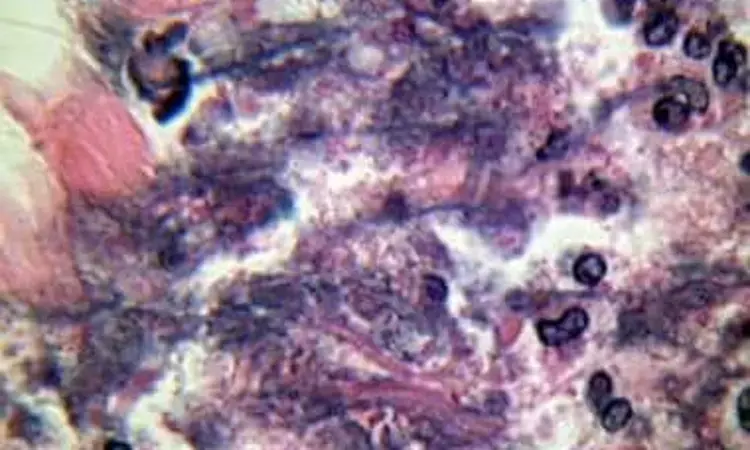- Home
- Medical news & Guidelines
- Anesthesiology
- Cardiology and CTVS
- Critical Care
- Dentistry
- Dermatology
- Diabetes and Endocrinology
- ENT
- Gastroenterology
- Medicine
- Nephrology
- Neurology
- Obstretics-Gynaecology
- Oncology
- Ophthalmology
- Orthopaedics
- Pediatrics-Neonatology
- Psychiatry
- Pulmonology
- Radiology
- Surgery
- Urology
- Laboratory Medicine
- Diet
- Nursing
- Paramedical
- Physiotherapy
- Health news
- Fact Check
- Bone Health Fact Check
- Brain Health Fact Check
- Cancer Related Fact Check
- Child Care Fact Check
- Dental and oral health fact check
- Diabetes and metabolic health fact check
- Diet and Nutrition Fact Check
- Eye and ENT Care Fact Check
- Fitness fact check
- Gut health fact check
- Heart health fact check
- Kidney health fact check
- Medical education fact check
- Men's health fact check
- Respiratory fact check
- Skin and hair care fact check
- Vaccine and Immunization fact check
- Women's health fact check
- AYUSH
- State News
- Andaman and Nicobar Islands
- Andhra Pradesh
- Arunachal Pradesh
- Assam
- Bihar
- Chandigarh
- Chattisgarh
- Dadra and Nagar Haveli
- Daman and Diu
- Delhi
- Goa
- Gujarat
- Haryana
- Himachal Pradesh
- Jammu & Kashmir
- Jharkhand
- Karnataka
- Kerala
- Ladakh
- Lakshadweep
- Madhya Pradesh
- Maharashtra
- Manipur
- Meghalaya
- Mizoram
- Nagaland
- Odisha
- Puducherry
- Punjab
- Rajasthan
- Sikkim
- Tamil Nadu
- Telangana
- Tripura
- Uttar Pradesh
- Uttrakhand
- West Bengal
- Medical Education
- Industry
Vacuum sealing drainage tied to reduced dressing changes and analgesic use after surgery in Fournier's gangrene

Fournier's gangrene (FG) is a severe form of soft tissue infection that occurs in the perianal, perineal, and genital regions characterized by purulent necrosis caused by multiple types of anaerobic and aerobic microorganisms
Vacuum sealing drainage linked to reduced dressing changes and analgesic use after surgery in Fournier’s gangrene suggests a new study published in the BMC Surgery.
Vacuum sealing drainage (VSD) is widely applied in complex wound repair. The researchers aimed to compare traditional debridement and drainage and VSD in treating Fournier’s gangrene Fournier’s gangrene (FG) is a severe form of soft tissue infection that occurs in the perianal, perineal, and genital regions characterized by purulent necrosis caused by multiple types of anaerobic and aerobic microorganisms. FG causes septic shock and multiple organ failure with mortality rates ranging from 4 to 67%. Surgical debridement removes necrotic tissue and drainage of lesions facilitates rapid control of systemic infection. However, FG causes extensive infection and requires repeated debridement, which leads to enlarged surgical wounds that make subsequent wound reconstruction difficult. Data of patients surgically treated for FG were retrospectively analyzed.
Results
Of the 36 patients (men: 31, women: 5; mean age: 53.5 ± 11.3 [range: 28–74] years) included in the study, no patients died. Between-group differences regarding sex, age, BMI, time from first debridement to wound healing, number of debridements, FGSI, and shock were not statistically significant (P > 0.05). However, lesion diameter, colostomy, VAS score, dressing changes, analgesic use, length of hospital stay, and wound reconstruction method (χ2 = 5.43, P = 0.04) exhibited statistically significant differences. Tension-relieving sutures (6 vs. 21) and flap transfer (4 vs. 2) were applied in Groups I and II, respectively.
VSD can reduce postoperative dressing changes and analgesic use, and shrunk the wound area, thereby reducing flap transfer in wound reconstruction.
Reference:
Chen, Jh., Li, Yb., Li, Dg. et al. Vacuum sealing drainage to treat Fournier’s gangrene. BMC Surg 23, 211 (2023).
https://doi.org/10.1186/s12893-023-02109-0
Keywords:
Vacuum, sealing, drainage, linked, reduced, dressing, changes, analgesic, use, after, surgery, Fournier’s gangrene, BMC Surgery
Dr. Shravani Dali has completed her BDS from Pravara institute of medical sciences, loni. Following which she extensively worked in the healthcare sector for 2+ years. She has been actively involved in writing blogs in field of health and wellness. Currently she is pursuing her Masters of public health-health administration from Tata institute of social sciences. She can be contacted at editorial@medicaldialogues.in.
Dr Kamal Kant Kohli-MBBS, DTCD- a chest specialist with more than 30 years of practice and a flair for writing clinical articles, Dr Kamal Kant Kohli joined Medical Dialogues as a Chief Editor of Medical News. Besides writing articles, as an editor, he proofreads and verifies all the medical content published on Medical Dialogues including those coming from journals, studies,medical conferences,guidelines etc. Email: drkohli@medicaldialogues.in. Contact no. 011-43720751


